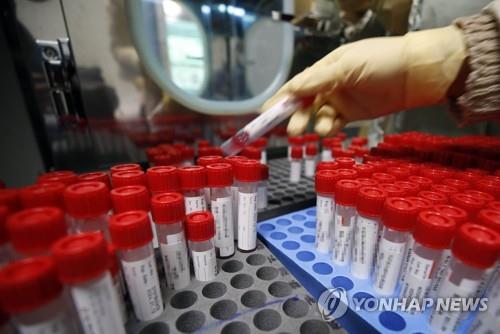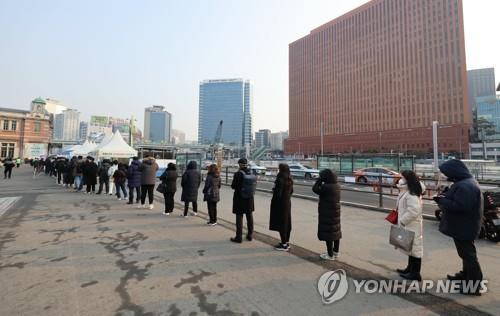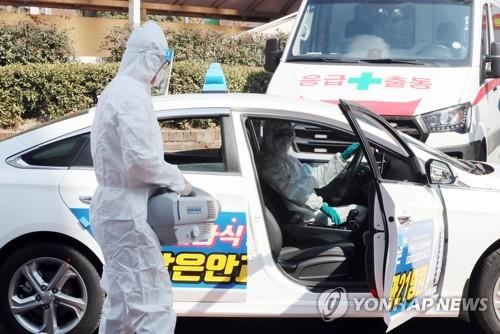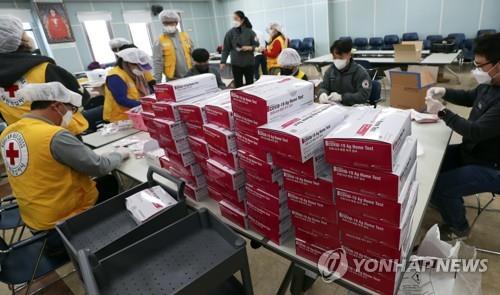- California Assembly OKs highest minimum wage in nation
- S. Korea unveils first graphic cigarette warnings
- US joins with South Korea, Japan in bid to deter North Korea
- LPGA golfer Chun In-gee finally back in action
- S. Korea won’t be top seed in final World Cup qualification round
- US men’s soccer misses 2nd straight Olympics
- US back on track in qualifying with 4-0 win over Guatemala
- High-intensity workout injuries spawn cottage industry
- CDC expands range of Zika mosquitoes into parts of Northeast
- Who knew? ‘The Walking Dead’ is helping families connect
Daily COVID-19 cases fall below 170,000 amid concerns over critical cases
South Korea’s daily COVID-19 cases fell below 170,000 on Friday, but critical cases and deaths from the virus rose at a fast pace amid the continued spread of the highly contagious omicron variant.
The country reported 165,890 new COVID-19 infections, including 165,749 local cases, raising the total caseload to 2,665,077, according to the Korea Disease Control and Prevention Agency (KDCA).
It is slightly down from the previous day’s 170,015. Daily infections surpassed the 100,000 level for the first time last week and soared to a record high of 171,442 on Wednesday.
Prime Minister Kim Boo-kyum said that the daily caseload could rise to as high as 250,000 by mid-March when the omicron wave is forecast to reach the peak.
The number of critically ill COVID-19 patients grew sharply to 655 on Friday from the previous day’s 581. Compared with a week earlier, the figure surged about 70 percent.
The country added 94 more deaths from COVID-19 in the day, more than doubling in a week. The death toll came to 7,783, and the fatality rate was 0.29 percent, according to the KDCA.
As of 6 p.m. Friday, the country had reported a total of 135,986 cases nationwide, up 553 from the same time the previous day, according to health authorities and local governments.
Daily cases are counted until midnight and announced the following morning.




A medical worker checks COVID-19 test samples at a makeshift testing station in the southwestern city of Gwangju on Feb. 23, 2022, in this photo provided by a local government. (PHOTO NOT FOR SALE) (Yonhap)
The government has said it will continue to focus on dealing with serious cases and preventing deaths to effectively handle the omicron wave under the current medical system, citing the milder severity of the variant.
Instead of rigorous contact tracing and treatment, the government opted for an enhanced at-home treatment and self-diagnosis scheme.
The number of patients receiving at-home treatment hit another high of 651,081 on Friday, the KDCA said.
The government also decided to further ease rules on mandatory isolation for unvaccinated people to reduce the administrative burden for health authorities.
Currently, a seven-day isolation is a must for those who are not vaccinated and live with virus patients. But self-monitoring will be allowed starting next month regardless of their vaccination record, according to the KDCA.
It will also lift rules on mandatory virus tests for quarantined family members. Instead of rigorous polymerase chain reaction (PCR) tests twice to exit isolation, they are only recommended to undergo two rounds of tests, including one with a self-testing kit, the KDCA said.
“We need to make a decision on where to concentrate our resources. Our priority is to help patients receive proper treatment and carry out related follow-up measures,” KDCA official Park Young-jun said.
In a move to better protect young people and pregnant women, the government decided to set aside more hospital beds for them and enhanced an emergency care system to ensure their swift transfer to medical clinics for treatment.
Recently, concerns have risen over the safety of such vulnerable groups. Earlier this week, a four-month-old baby died after receiving COVID-19 treatment at home, which took place less than a week after a seven-month-old baby died while being sent to hospital for coronavirus treatment.
The country has seen a surge in infections among young people, with those aged 18 or younger accounting for around 25 percent of the total patients.
But they are also supposed to be treated at home and some local clinics have refused to accept suspected cases among young and pregnant people, citing limited medical capacity.
Amid a manpower shortage, the government adopted a new guideline that allows medical workers to return to work after three days of isolation following their infection, even though they do not have proof of negative test results. Their return is possible when they have no symptoms, the health authorities said.
It also plans to send 3,000 officials of central government agencies and 1,000 military members to public health care centers to support at-home treatment patients and other administrative roles.
As of Friday, 31.0 million people, or 60.4 percent of the country’s 52 million population, had received booster shots. The number of fully vaccinated people came to 44.33 million, accounting for 86.4 percent, according to the KDCA.
The government has called on the people to get vaccinated, as a booster shot reduces chances of developing serious cases, as well as deaths from COVID-19, by more than 80 percent under the current wave.
On Sunday, South Korea will bring in additional Paxlovid antiviral treatment pills made by U.S. drugmaker Pfizer Inc. for 41,000 people, which is part of the medication that the country has secured for 762,000 people, the KDCA said.
So far, pills for 32,000 people have been brought in, and 17,660 patients had taken the drugs as of Thursday since the beginning of its prescription in mid-February.
The pills are available for those aged 60 and older, those with compromised immune systems, and people in their 40s and 50s with underlying diseases. Patients are administered three Paxlovid pills twice a day for five days.











